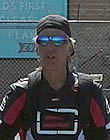|
|
This topic comprises 2 pages: 1 2
|
|
Author
|
Topic: Christie SLC Lamphouse - Hard to strike
|
Joe Redifer
You need a beating today

Posts: 12859
From: Denver, Colorado
Registered: May 99
|
 posted 03-21-2010 08:22 AM
posted 03-21-2010 08:22 AM





Preface:
1 - I have a Christie SLC-30 lamphouse that is using Christie CXL-20 bulbs (the rectifier is turned down to allow this). I have used an amp clamp or whatever it is called to verify the amperage and voltage (that part checked with a multimeter) do not exceed 2000 watts as I never trust the amp meters on any lamphouse. It runs at about 1920 watts or so, if I recall.
2 - About a month ago I also posted about the intake blower having a very difficult time starting up in the morning and that I never let them turn off at night (or ever) as a result. This has yet to be replaced (does anyone have a part number for the intake blower assembly from Christie? It's not in the Manuals section). The motor for this part is clearly wearing out, yet is still strong enough to give me a green light on the side of the lamphouse. However a manager has reported that the green light went off for him one day and the bulb would not even try to strike, but after multiple tries it stayed on and finally worked. There is no wind vane for the exhaust in ANY of our lamphouses, but I can feel the air sucking to the roof. The roof exhaust is always on, 24/7.
3 - These lamphouses were purchased used locally and I have no idea what their history might be, but I doubt that they were well maintained in their previous life.
Problem:
This lamphouse usually takes anywhere from 7-15 strikes to ignite a bulb and have it stay lit (which is probably murder on the bulb). When I put a brand new bulb in, it strikes right away the first time, every time. But a week later it is taking upwards of 5 strikes to ignite and the number of strikes required will probably increase each week.
So might there be a ventilation issue where the bulb is wearing out prematurely? The lamphouse never seems excessively hot. Or should I just get a new igniter? I have had tons upon tons of issues with igniters in the past with Christie SLC lamphouses at other theaters and have replaced them quite often, but I have never seen a bad igniter able to strike a new bulb with a single strike.
Basically I think it is the igniter, but I just want a second, third or 20th opinion. I'm just glad I don't have the Christie rectifier buzz.
| IP: Logged
|
|
|
|
|
|
|
|
|
|
|
|
|
|
|
|
|
|
|
|
|
|
|
|
|
|
|
|
|
|
|
|
All times are Central (GMT -6:00)
|
This topic comprises 2 pages: 1 2
|
Powered by Infopop Corporation
UBB.classicTM
6.3.1.2
The Film-Tech Forums are designed for various members related to the cinema industry to express their opinions, viewpoints and testimonials on various products, services and events based upon speculation, personal knowledge and factual information through use, therefore all views represented here allow no liability upon the publishers of this web site and the owners of said views assume no liability for any ill will resulting from these postings. The posts made here are for educational as well as entertainment purposes and as such anyone viewing this portion of the website must accept these views as statements of the author of that opinion
and agrees to release the authors from any and all liability.
|

 Home
Home
 Products
Products
 Store
Store
 Forum
Forum
 Warehouse
Warehouse
 Contact Us
Contact Us




 Printer-friendly view of this topic
Printer-friendly view of this topic









![[Smile]](smile.gif)
![[Big Grin]](biggrin.gif)



